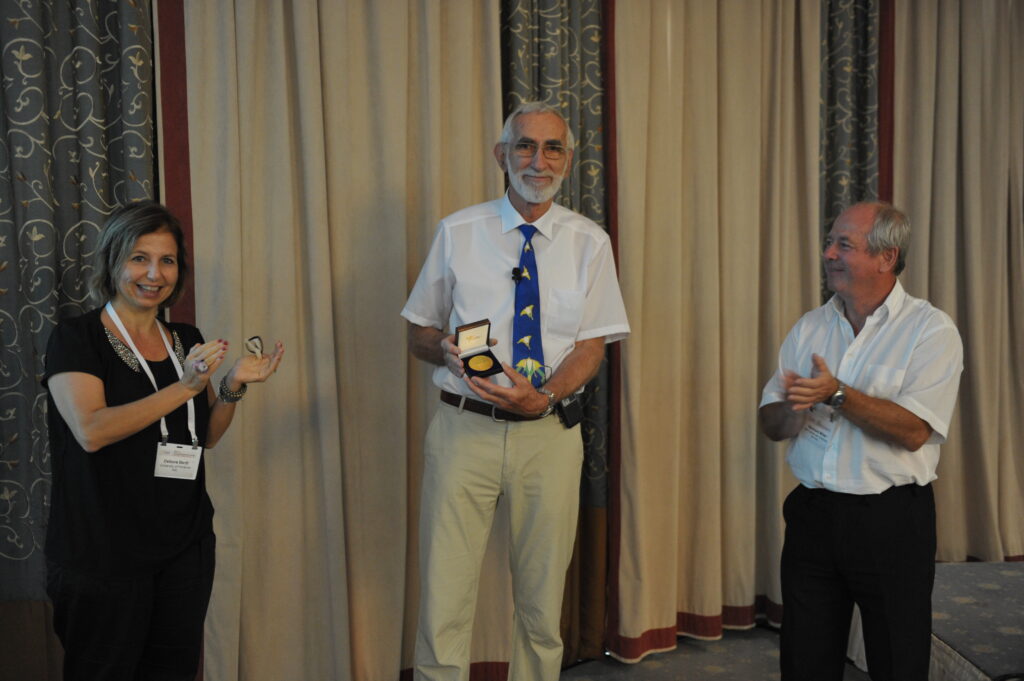
Otto Glatter (Graz) center with Deborah Berti and Reinhard Miller
The 2013 Overbeek Gold Medal Winner is Prof. Dr. Otto Glatter, Graz, Austria. He is awarded the medal for his lifelong contributions to the development of scattering techniques and their application to colloidal systems.
Structural analysis is one of the most important topics in science. In colloid science structural analysis is particularly difficult because the objects are often smaller than the wavelength of light and they need to be analyzed in liquid environment. Otto Glatter can well be called as the father of small angle X-ray scattering (SAXS) in colloid science. SAXS has developed into an indispensable technique to characterize colloidal system.
With his first project Otto Glatter came already into contact with SAXS. Supervised by Otto Kratky he studied the substructure of hemocyanine. What followed as a series of papers in which he paved the way of applying SAXS to analyze colloidal systems. He improved the experimental setup and, even more important, facilitated and refined the analysis and evaluation of the SAXS data. He is the one who introduced SAXS into colloid science. His book, Small Angle X-ray Scattering (1982, Academic Press) edited together with Kratky, is a good example not only of his own original research but also of his ability to publicize his technique to a wide community.
Probably his most important contribution was the development and improvement of the theory to evaluate scattering data. He laid the foundation of analyzing SAXS results quantitatively. Initially, Otto Glatter focused on SAXS of dilute solutions. Later he extended his theory in different directions: He analyzed non-spherical particles like rods or lamellar structures. In his so called Generalized Indirect Fourier Transformation (GIFT) method he simultaneously evaluated the structure and the form factor of non-dilute solutions. He deconvoluted the pair-distribution function of spherical particles into a density profile. This allowed him to analyze the internal structure of micelles. His approach is equally applicable to small angle neutron diffraction (SNAS). Therefore many of his studies were carried out with neutrons rather than X-rays.
Being an expert on scattering, it was natural for Otto Glatter to also work on light scattering. He contributed significantly to our understanding of static and dynamic light scattering. We would like to mention in particular his work on dynamic light scattering of turbid and thus dense suspensions. Going in the same direction as with X-rays – from dilute to interacting colloids – he developed an easy to apply flat scattering cell for studying turbid suspensions, developed the evaluation method and applied it to many important colloidal systems.
The great success of the work of Otto Glatter is due to two factors. First, he developed the instrumentation with the evaluation theory. This allowed characterizing properties which were hidden before. Second, he applied this instrumentation to answer important scientific questions in colloid science. This interrelation between important colloidal systems and new instrumentation not only allowed him to demonstrate the capabilities of instrumental developments, it also provided direction to method development.
Naturally, the scientific question addressed and the colloidal system analyzed changed over the years. One of the first questions Otto Glatter addressed was on the structure of lipoproteins, a radial symmetric object with an inner structure which, he continued to study event to recent years. Micellization in aqueous surfactant solutions was another topic Otto Glatter worked on. Based on his firm knowledge of small angle scattering he also studied the structure of more complex amphiphiles such as blockcopolymers. From understanding the aggregation of amphiphiles it was one step further to also study different types of emulsions, in particular microemulsions. Again, he went from simple to unusual or complex systems. Examples are his studies of carbon dioxide-in-water microemulsions and his analysis of the transfer kinetics of monoglyceride and n-alkanes in water, i.e. between cubosomes and emulsion droplets.
During the last years he increasingly focused on the study of hierarchically organized systems. Some low HLB lipids form liquid crystals when in contact with water. This hydrophobic material with high viscosity can be used to create oil-in-water, water-in-oil emulsions and dry films. The lipid phase is either a nanostructured liquid crystal or a microemulsion. In the later case the result is an emulsified water-in-oil microemulison. These systems have potential applications in food, pharmaceutical, agro-chemistry and cosmetics. All the structures formed are characterized by SAXS and light scattering.
Otto Glatter did his scientific education and whole career at the University of Graz, complemented by 6 months as a guest professor at the Research Center in Jülich. He received his PhD in 1972 supervised by Ledinegg and Kratky. After doing his habilitation in experimental physics (1980) and physical chemistry (1985) he became professor at the Institute of Physical Chemistry University of Graz. From 1999-2009 he served as head of the whole chemistry department. Otto Glatter is a hand-on scientist by heart. He takes pleasure in doing an experiment and analyzing the results. This is also visible from his publication list with more than 30 publications with himself as a first author. Otto Glatter was a co-organizer of the 1992 ECIS conference in Graz.
